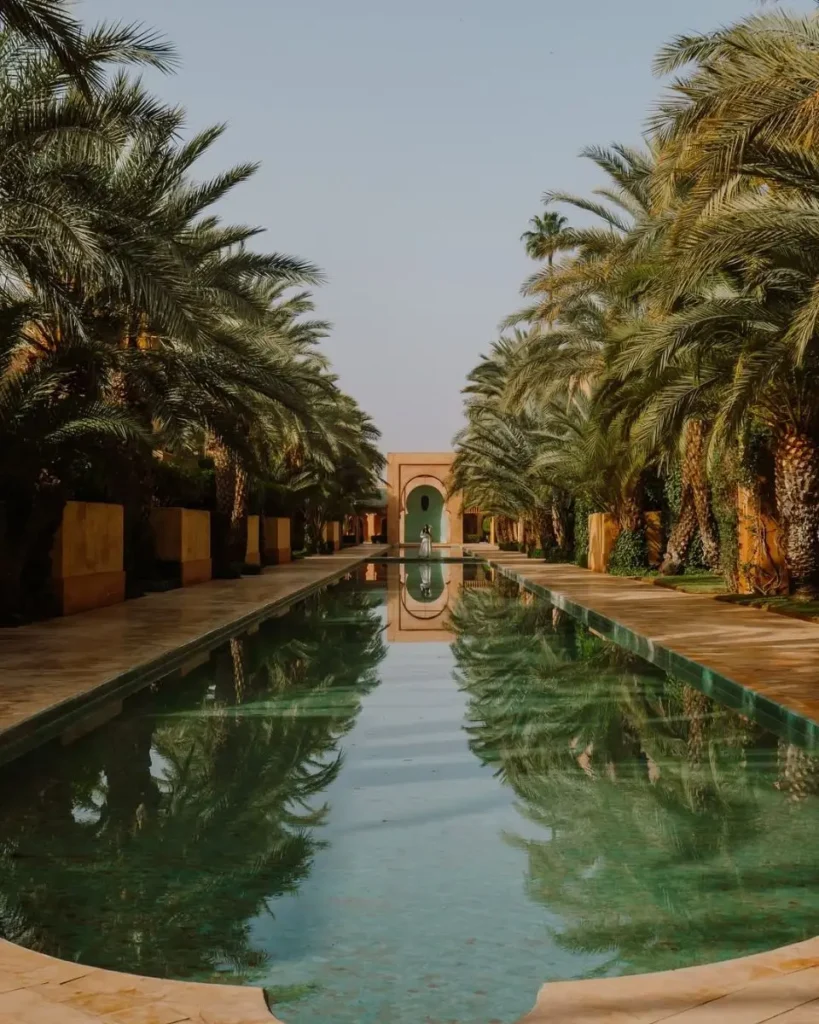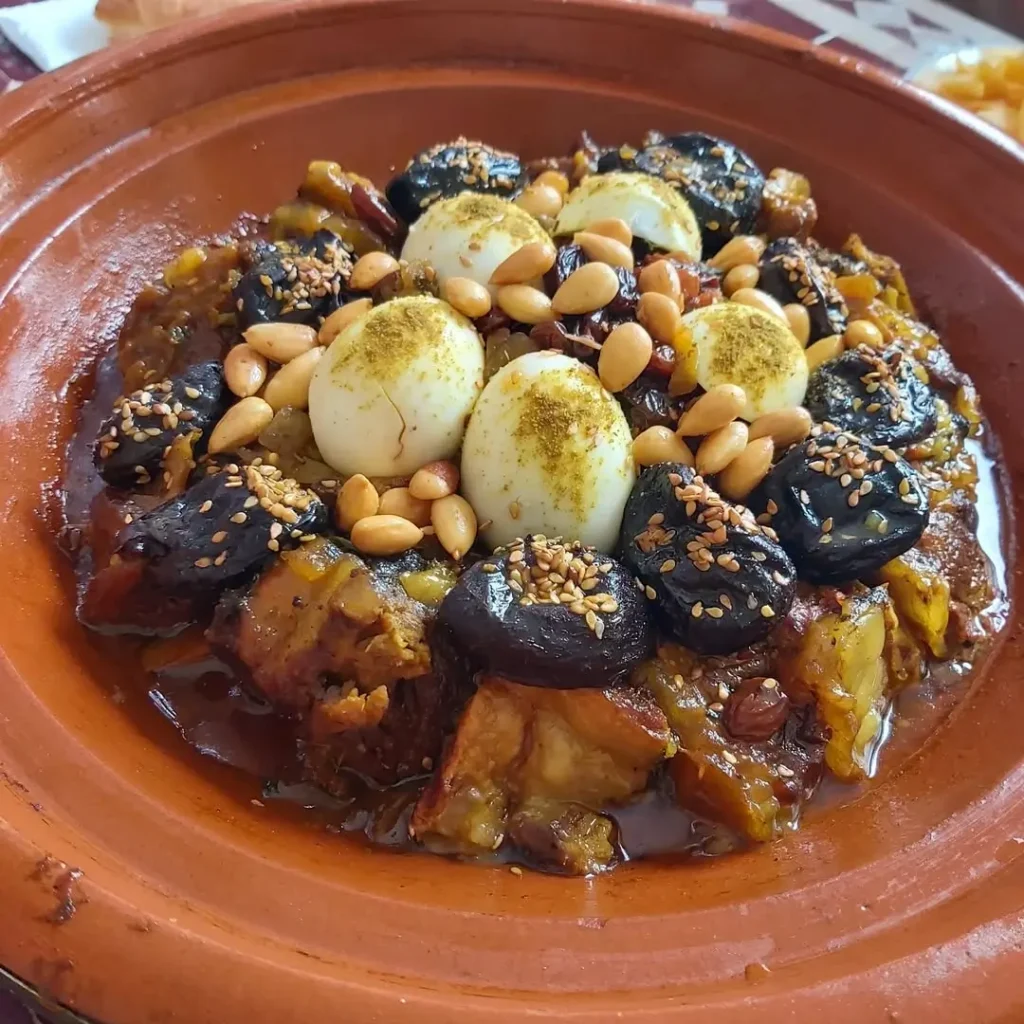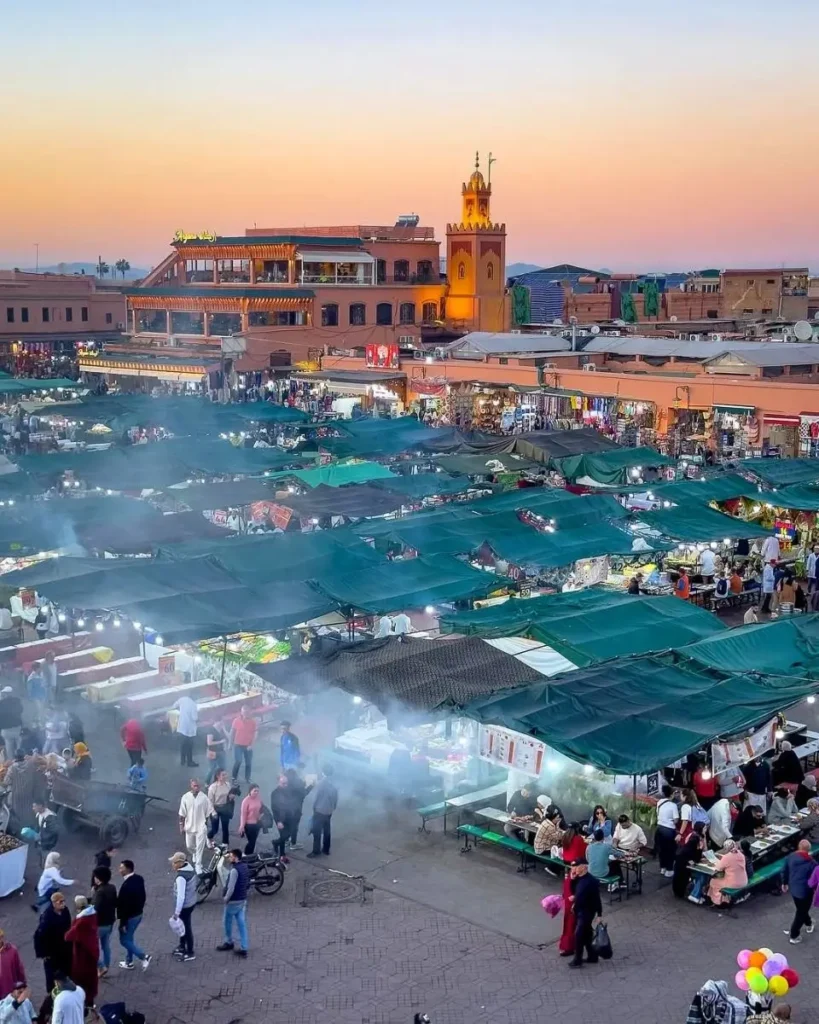Table of Contents
Welcome to the magical Red City of Marrakech! Honestly, this place is something else. Prepare yourself for an explosion of colours, sounds, and smells that will awaken every single one of your senses. It’s a city that truly buzzes with life!
Marrakech isn’t just a dot on the map; it’s a legendary cultural and trading spot right at the feet of the stunning Atlas Mountains. It’s world-famous for its incredibly lively souks, magnificent historical palaces, and gardens so beautiful they’ll take your breath away. Trust me, finding amazing things to do in Marrakech is never a challenge.
But there’s more to Marrakech than just its fascinating history. It’s a city that calls out to the adventurer in you, offering unique experiences you won’t find anywhere else. From incredible Marrakech attractions to quiet moments of discovery, this city has it all.
So, why this guide? Well, I’ve put together all the local secrets and expert tips to help you explore this enchanting city like a pro. This Marrakech travel guide is designed to make sure you have an absolutely unforgettable trip, and guess what? It’s also amazing value for money compared to many other exotic spots. You’re going to have the best time.
Planning Your Trip to Marrakech: Essential Pre-Travel Info
Before you dive into all the exciting things to do in Marrakech, a little planning goes a long way. Getting these bits sorted will mean a smoother, more enjoyable adventure.
Best Time to Visit Marrakech (and When to Avoid)
Timing your visit can make a big difference!
- Optimal Value & Weather: Spring (that’s March to May) and Autumn (September to November) are just perfect. The temperatures are lovely and comfortable for exploring. If you’re looking for the best deals, early May and late September are often spot on.
- Cheapest Season: You’ll find the lowest prices from June to August, but oh boy, it gets hot! We’re talking temperatures often soaring over 100°F (38°C). So, if you’re not a fan of intense heat, maybe give this time a miss.
- Most Expensive Season: December to March, especially around the Christmas and New Year holidays, and also November, tend to be pricier.
- Ramadan Considerations: Visiting during Ramadan can be a really interesting cultural experience. However, do remember that opening hours for shops and attractions might change, and the general pace of the city slows down a bit during the day. It’s definitely something to be aware of when planning your Marrakech itinerary.
Where to Stay: Old Medina vs. Modern City (Gueliz)
Choosing your base is a key part of your Marrakech travel tips!
- The Old Medina: Authentic & Historic Immersion
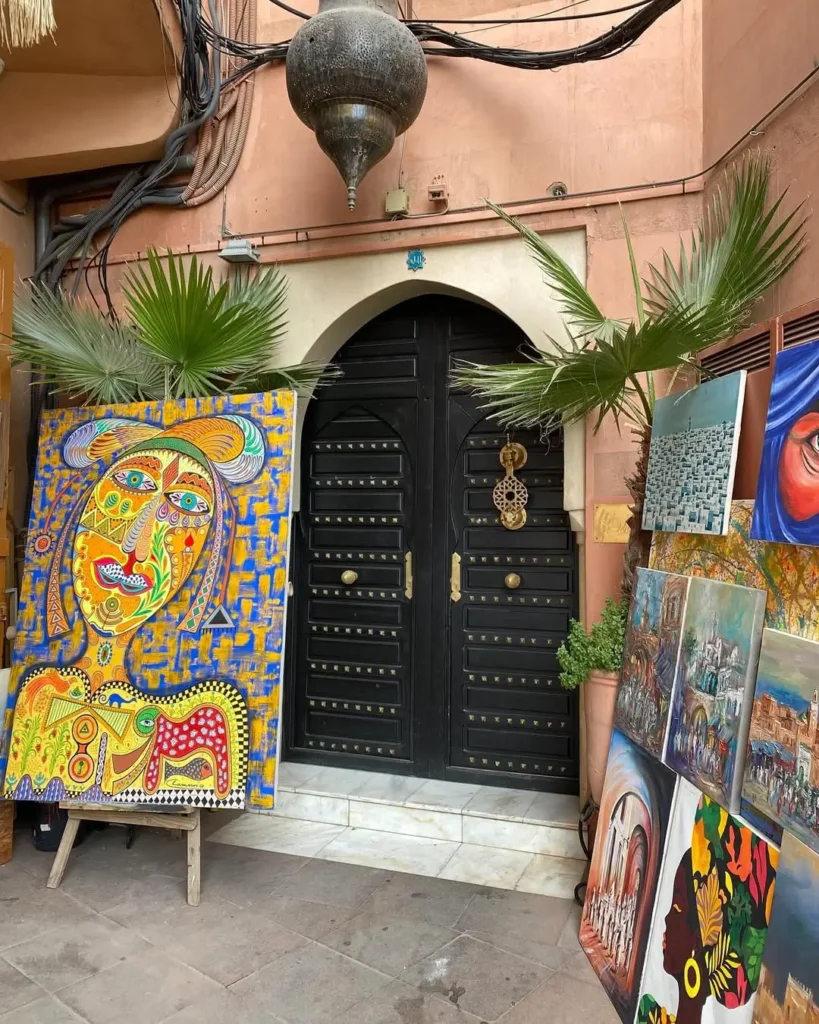
- Honestly, for first-timers, I’d really recommend staying in the Old Medina. It’s where you’ll find that authentic, historic vibe.
- Think about booking a traditional riad. These gorgeous guesthouses have inner courtyards that are like peaceful little oases, a perfect escape from the exciting, chaotic streets. Riad Itrane is a lovely example.
- It’s also super handy for walking to most of the main Marrakech attractions.
- The Modern City (Gueliz): Convenience & Familiarity
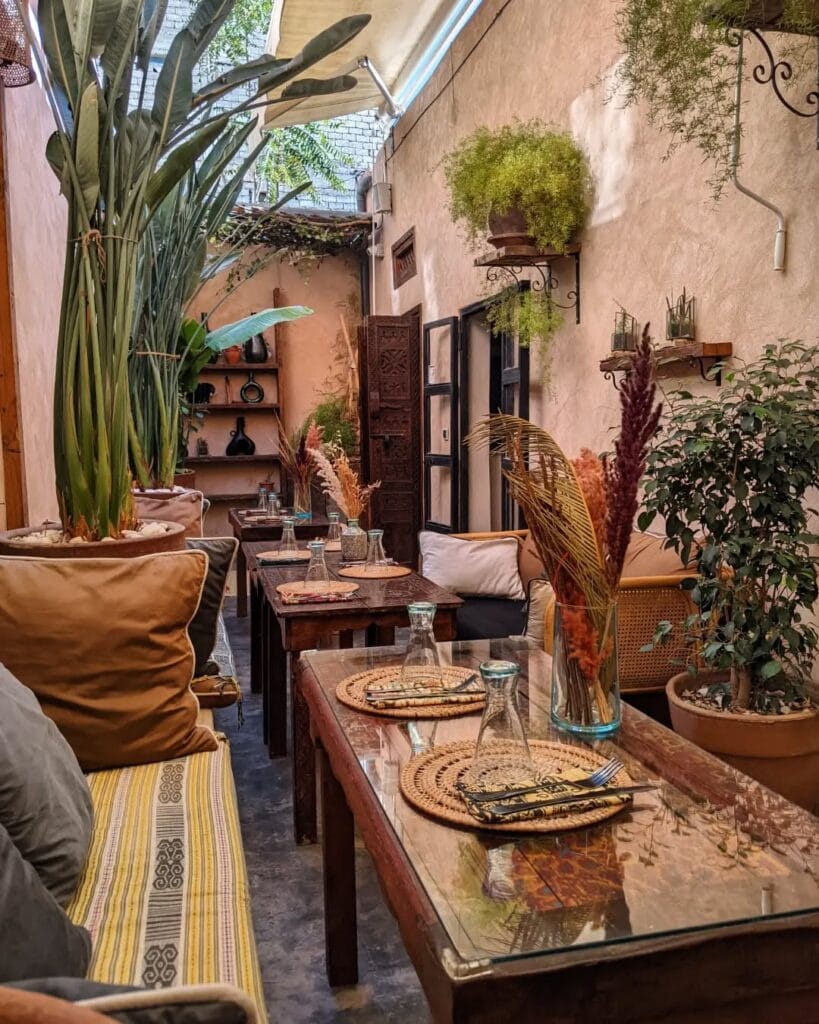
- Gueliz offers a different feel with wider roads, international hotels, modern shops, and familiar cafés.
- It can be more convenient if you’ve got an early train or flight, as getting transport is generally a bit easier from here.
Understanding Costs & Budgeting for Marrakech in 2025
Good news! Marrakech is generally much more affordable than big Western cities. You’re looking at prices typically 60-70% lower, which means your money can go a lot further here. That’s exceptional value!
- Daily Budget Breakdowns (approximate):
- Budget Travellers: You could manage on $30-50 per day.
- Mid-Range Travellers: $80-150 per day will get you a very comfortable experience.
- Luxury Travellers: $200+ per day opens up some seriously fancy options, and even then, it’s often better value than luxury in Western capitals.
- Specific Expense Categories (approximate in USD):
- Accommodation: Hostels (
10−20),BudgetRiads(10−20),BudgetRiads(25-40), Mid-range Riads (50−100),LuxuryRiads(50−100),LuxuryRiads(150+). - Food: Street food (
1−5),localrestaurants(1−5),localrestaurants(4-8). Eating well is one of the top things to do in Marrakech and it doesn’t have to cost a fortune! - Alcohol: This is notably more expensive as Morocco is a Muslim country. Beer (
4−10),Wine(4−10),Wine(5-60 for a bottle). Available in licensed hotels, bars, and some restaurants. - Transportation: Petit Taxis ($2-5 per ride in town), public bus (around $0.40). The Medina is mostly walkable, which is great!
- Activities & Attractions: Generally 60-70% cheaper than similar attractions elsewhere. Palace entry fees (like Bahia Palace, El Badi Palace, Jardin Majorelle, Madrasa Ben Youssef) are typically around $7-15 each.
- Accommodation: Hostels (
- Currency & Payment: The official currency is the Moroccan Dirham (MAD). While bigger places like hotels and some restaurants will take credit cards, cash is absolutely king for smaller shops, market stalls, and most taxis. Make sure you have some dirhams on you.
Safety, Scams & Practical Tips for a Smooth Visit
Marrakech is generally a safe city for tourists, but like any bustling place, it’s good to be aware.
- General Safety: Just keep your wits about you, especially in crowded areas.
- Common Scams to Avoid:
- Overly “helpful” locals offering directions and then demanding payment. A polite “no, thank you” (“La, shukran”) usually works.
- Unauthorized henna artists, especially in Jemaa el-Fnaa. The black henna they sometimes use can cause nasty skin reactions. If you want henna, find a reputable salon.
- Animal handlers in Jemaa el-Fnaa with monkeys or snakes. It’s best to avoid these as it often involves animal mistreatment.
- Watered-down fruit juices from some vendors in the main square. Look for stalls where locals are buying.
- Shopping & Money: Always, always negotiate prices when shopping in the souks. It’s part of the culture and totally expected! Keep your valuables secure, and be mindful of pickpockets in busy spots. Stick to bottled water to be on the safe side.
- Local Interactions: Most Moroccan people are incredibly friendly and welcoming. Shop owners will invite you into their shops to look at their goods; a polite “no, thank you” is fine if you’re not interested.
- Roof Terrace Views: So many cafés and restaurants have amazing rooftop terraces. They’re perfect for escaping the hustle for a bit, enjoying a mint tea, and watching the sunset over the city. This is definitely one of the simple but brilliant things to do in Marrakech.
Top Things to Do in Marrakech: Must-See Attractions & Experiences
Alright, let’s get to the really exciting stuff! Marrakech is packed with incredible sights and experiences. You’ll be spoilt for choice.
Get Lost (Delightfully) in the Vibrant Souks
The souks are the absolute beating heart of Marrakech’s Medina. Imagine a massive maze of narrow streets, each one overflowing with colorful goods, enticing smells, and the general hubbub of daily life. It’s an experience in itself and a must-see Marrakech highlight!
- Major Souks & What You’ll Find:
- Souk Semmarine:
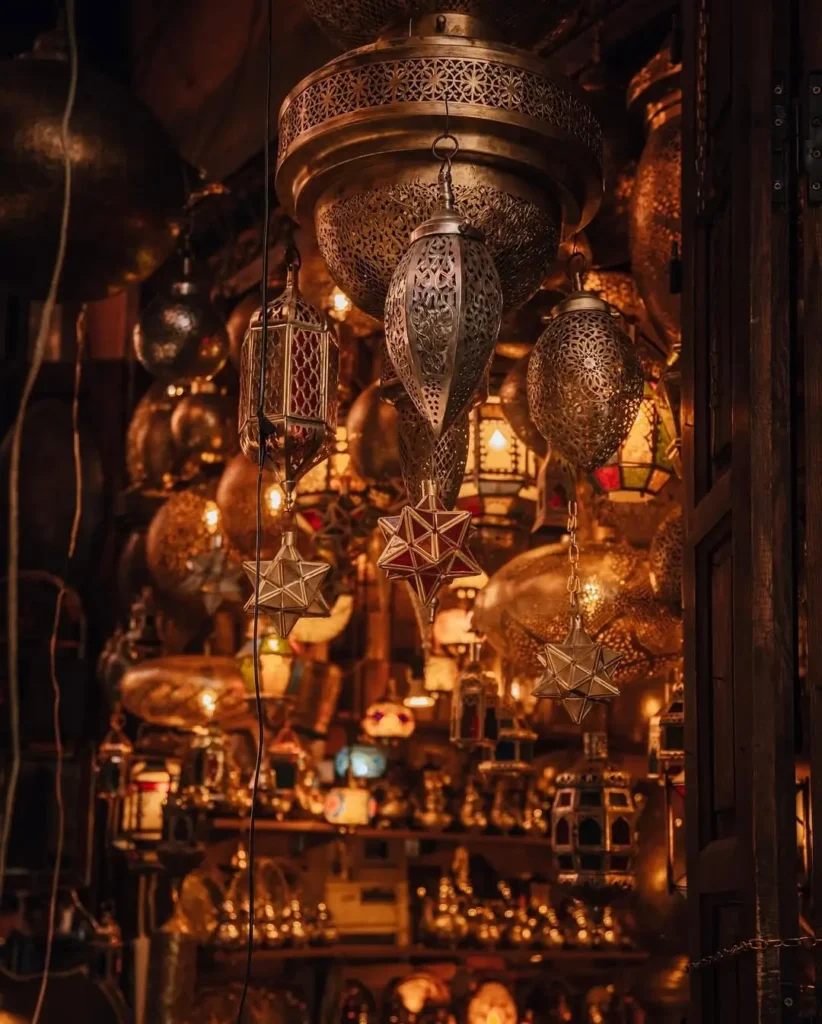
This is the main artery, and you’ll find a bit of everything here, from traditional pottery and tagine pots to beautiful textiles, lamps, and leather goods.
- Souk El Attarine: Get ready for a feast for your nose! This souk is all about spices, perfumes, essential oils, and shiny brass and metalwork like lanterns and teapots.
- Souk Smata (Slipper Souk): Babouches everywhere! Hundreds and hundreds of colourful traditional Moroccan leather slippers in every imaginable style.
- Souk Cherratine (Leather Souk): If you’re after leather bags, wallets, belts, or even jackets, this is your place. It’s often located near the tanneries.
- Souk Zrabi (Carpet Souk): Prepare to be amazed by the incredible Berber rugs and Moroccan carpets. The colours and patterns are stunning.
- Souk Haddadine (Blacksmiths’ Souk): Listen for the sound of hammers! Here you’ll find traditional lanterns, lamps, and other intricate metalwork being crafted.
- Souk Chouari (Carpenters’ Souk): The wonderful scent of cedarwood often fills the air here. You’ll find beautifully carved wooden boxes, chess sets, furniture, and decorative items.
- Rahba Kedima (Spice Square): Not just spices in vibrant pyramids, but also traditional remedies, colourful baskets, and sometimes even live chameleons! There are some great rooftop cafes here too.
- Shopping Tips & Haggling Like a Pro: This is one of the most talked-about things to do in Marrakech!
- Haggling is Expected: Don’t be shy! Prices are rarely fixed. A good rule of thumb is to counteroffer about half the initial price and then aim to meet somewhere in the middle.
- Keep it Light-Hearted: Haggling is like a friendly game. Smile, be polite, and enjoy the process.
- “Morning Magic”: Some believe shopkeepers are keen to make their first sale of the day (for ‘baraka’ or good luck), so shopping early (around 9-10 AM) might get you slightly better deals.
- Carry Cash (Moroccan Dirhams): Most vendors in the souks are cash-only. It’s helpful to have smaller denominations.
- Know Ballpark Prices: Before you start buying, wander around a bit to get a general idea of what things cost.
- Bargaining Etiquette: Start with a smile and a friendly greeting like “Salam alaykum.” A bit of small talk can be nice. Don’t insult the products, but be firm and a little nonchalant about whether you’ll buy. Once you agree on a price, it’s generally expected that you’ll make the purchase.
- Be Aware: Politely decline any unsolicited “guides” who offer to show you around – they’ll likely lead you to specific shops and expect a tip. Keep your bags zipped and valuables out of sight.
- Best Time to Shop: Mornings (9-11 AM) are often less crowded, or late afternoon. Most souks are open from around 9-10 AM until 8-9 PM.
Discover Marrakech’s Rich History in its Palaces & Madrasas
Marrakech is steeped in history, and its palaces and old schools are truly breathtaking. Luckily, most of these key Marrakech attractions are within walking distance of each other in the Medina.
- Madrasa Ben Youssef: This place is absolutely stunning. It used to be an Islamic college and was once the largest in North Africa. The geometric patterns, intricate cedar woodwork, and beautiful zellij tiles are just incredible. The central courtyard with its reflective pool is so photogenic – you’ll want to take a million pictures!
- Bahia Palace: This 19th-century palace is one of the best-preserved historical sites in Marrakech. It was built for a grand vizier and really shows off the skill of Moroccan artisans. Think beautiful courtyards, stunning painted ceilings, and incredibly detailed tile decorations. It was all about showing off wealth and prestige, and it really does! The gardens are also a lovely, peaceful spot to wander through. Just a heads up, photography isn’t always allowed in all arias inside.
- El Badi Palace: Though mostly in ruins now, this 16th-century palace still gives you a powerful sense of its former glory. It was once incredibly lavish. Today, it’s a vast, peaceful space with sunken orange groves and even storks nesting on the old walls, which adds a unique atmosphere. Exploring these historic sites is high on the list of essential things to do in Marrakech.
Find Serenity at Jardin Majorelle & Yves Saint Laurent Museum
Need a break from the hustle and bustle? Jardin Majorelle is your answer. It’s one of the most famous and beautiful Marrakech attractions.
- This garden is an oasis of calm, famous for its incredible cobalt blue buildings – a colour now known as “Majorelle Blue” – and its collection of exotic plants and cacti from all over the world.
- History: It was designed by the French painter Jacques Majorelle over many years. Later, it was bought and lovingly restored by the fashion designer Yves Saint Laurent and his partner Pierre Bergé, who saved it from being turned into a hotel complex.
- Visiting Tips: You absolutely must book your tickets and time slots online in advance. They sell out really quickly, especially during peak season. Try to arrive early in the morning to enjoy the garden when it’s a bit quieter and cooler.
- What to See: Majorelle’s former painting studio is now home to a small but fascinating Berber Museum. There’s also a lovely café, a boutique shop, and a library. The Yves Saint Laurent Museum, dedicated to the designer’s work, is just a short walk away and well worth a visit if you’re interested in fashion.
Embrace the Chaos & Charm of Jemaa el-Fnaa Square
Jemaa el-Fnaa is the main square and the vibrant, chaotic, and utterly captivating heart of Marrakech. There’s nothing quite like it! It’s an essential part of any Marrakech itinerary.
- Evening Spectacle: While it’s busy during the day, the square truly comes alive as the sun begins to set. Food stalls appear as if from nowhere, filling the air with delicious smells. Storytellers captivate crowds, musicians play traditional tunes, and street acrobats perform. It’s a full-on sensory experience!
- Activities & Experiences:
- Mint Tea on a Rooftop: This is a classic Marrakech experience. Find a café with a rooftop terrace overlooking the square, order a traditional (very sweet!) mint tea, and just watch the incredible scene unfold below. It’s one of the best things to do in Marrakech at sunset.
- Taste Local Specialties: If you’re feeling adventurous, you can try local delicacies like sheep’s head or snails from the food stalls. Or, you can simply enjoy the atmosphere and opt for something more familiar.
- Fresh Juices: You’ll see loads of stalls selling fresh fruit juices. Orange juice is very popular. However, be a little cautious with vendors right on the main square as some might dilute their juices.
- Admire Koutoubia Mosque: The magnificent Koutoubia Mosque, with its iconic 77-meter minaret, dominates the skyline near the square. Non-Muslims can’t go inside, but it’s beautiful to admire from the outside, especially when it’s lit up at night. It actually inspired other famous towers, like the Giralda in Seville.
- Negotiate with Traders: You’ll find plenty of people selling souvenirs and trinkets around the square. Expect friendly negotiation if you decide to buy something.
- Things to Watch Out For: This is where you’re most likely to encounter tourist traps. Be wary of unrequested henna applications (especially with black henna), and it’s best to avoid the animal handlers with monkeys and snakes due to animal welfare concerns.
Unique Experiences Beyond the Crowds
Looking for something a bit different? Marrakech offers some truly memorable and unique activities.
Hot Air Balloon Ride at Sunrise:
Imagine floating peacefully over the desert landscape as the sun rises, with the Atlas Mountains in the distance. It’s a truly magical experience, about a kilometre up in the air! Most tours include pickup from your accommodation, a light breakfast before the flight, the flight itself, and then a more substantial Berber breakfast after you land. Definitely a pricier option, but an unforgettable one.
Traditional Moroccan Hammam Experience:
This is a must-do Marrakech activity for a real taste of local culture and some serious pampering. It’s all about purification of the body and soul.
- Types: You can go to a local (public) hammam for an authentic, no-frills experience. These are very cheap (just a dollar or two plus a tip), but you’ll need to bring your own soap (savon beldi – Moroccan black soap) and a kessa glove for scrubbing. Or, you can opt for a tourist (private/spa-like) hammam, which offers a more luxurious and pampering experience, often with massages included. These cost more (from $20 up to $100 or more).
- What to Expect (Tourist Hammam): You might be given disposable underwear. The experience usually involves spending time in hot steam rooms, being doused with warm water, a vigorous scrub-down with Moroccan black soap using a kessa glove (you’ll be amazed at how much dead skin comes off!), and often a rhassoul clay body mask. It usually finishes with progressively cooler rinses. Nudity levels vary, but be prepared for a fairly intimate experience. It leaves your skin feeling incredibly soft!
Moroccan Culinary & Cultural Workshops
Cooking Class
Learn how to make delicious traditional Moroccan dishes like tagines or couscous, or even some of those delightful Moroccan sweets. A great souvenir to take home is new cooking skills!
Language Workshops
Why not learn a few basic phrases in Moroccan Darija (Arabic)? It’s fun and locals will appreciate the effort.
Henna Workshops
Discover the beautiful art of henna and maybe even learn to apply some simple designs.
Culinary Delights: What to Eat & Drink in Marrakech
Oh, the food! Exploring the local cuisine is one of the absolute best things to do in Marrakech. Get ready for a flavour explosion!
Must-Try Moroccan Dishes & Beverages
You’ll be spoilt for choice, but here are a few things you simply have to try:
- Fresh Juices: You’ll see vendors everywhere squeezing fresh juices. Pomegranate is a popular choice, as is orange. For the most authentic and best value, try to find local shops tucked away in the smaller streets rather than right on Jemaa el-Fnaa.
- Moroccan Pastries & Desserts: These are heavenly! Often made with almonds, honey, and fragrant spices like cinnamon and orange blossom water. They can be quite nutty and often remind people of marzipan. They’re usually sold by weight and are a big part of any Moroccan celebration.
- Tagines: This is the quintessential Moroccan dish. It’s a slow-cooked stew, usually made with meat (lamb, chicken, beef) or fish, along with vegetables, olives, preserved lemons, and wonderful spices. Cooked and served in a distinctive conical earthenware pot. You’ll find them everywhere, and they’re often very affordable.
- Couscous: While you can find it any day, couscous is traditionally served on Fridays. It’s often a communal dish with steamed semolina grains, tender meat, and a variety of vegetables.
- Harira Soup: A hearty and delicious traditional Moroccan soup, often eaten to break the fast during Ramadan, but available year-round. It’s typically made with tomatoes, lentils, chickpeas, and spices.
- Msemen: These are Moroccan pancakes – flat, layered, and often pan-fried. You can get them plain, or sweet with honey, or even savory with spiced fillings.
- Mint Tea: More than just a drink, it’s a symbol of Moroccan hospitality! It’s usually green tea with fresh mint leaves and a lot of sugar (though you can sometimes ask for less). It’s often served with a special ceremony, poured from a height to create a frothy top.
Where to Find the Best Food (and Avoid Tourist Traps)
Here are a few Marrakech travel tips for foodies:
- For those delicious and cheap fresh juices, dive into the side streets and look for small, local shops where you see Moroccans buying.
- The best and most authentic food is often found in small, unassuming local restaurants (sometimes called “snacks”) that are bustling with locals. These places offer fantastic value.
- Jemaa el-Fnaa square transforms into a massive open-air food court in the evening. It’s a vibrant experience, but be a little selective about the stalls. Some are better than others, and it can be a bit more tourist-priced.
Beyond Marrakech: Recommended Day Trips & Extensions
If you have a bit more time in your Marrakech itinerary, there are some fantastic places to explore nearby. Getting out of the city for a day can show you a whole different side of Morocco.
Atlas Mountains
Just a couple of hours’ drive from Marrakech, the Atlas Mountains offer breathtaking scenery, traditional Berber villages, and great hiking opportunities. It’s a world away from the city buzz.
Essaouira
This is a chilled-out coastal town, about a 2.5 to 3-hour drive from Marrakech. It’s famous for its beautiful beaches (though often windy – great for kite surfing!), fresh seafood, blue and white medina, and relaxed atmosphere.
Ouarzazate and Ait Ben Haddou
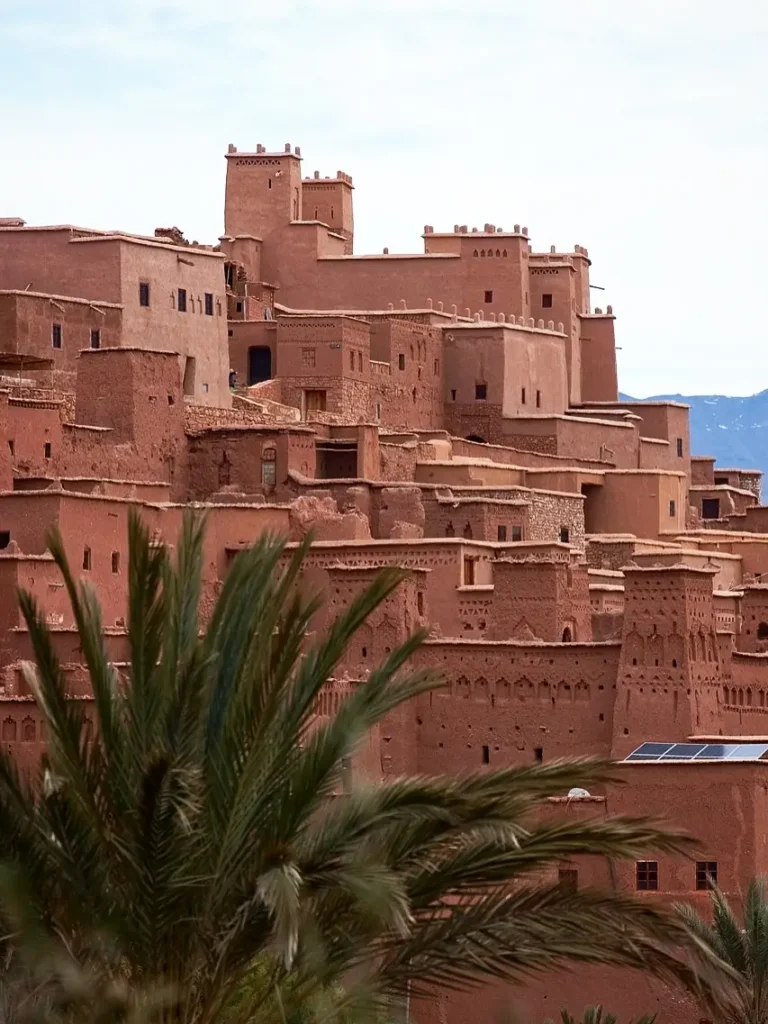
These are must-sees for film buffs! Ait Ben Haddou is an incredible ancient ksar (fortified village) that has been the backdrop for movies like Gladiator and Game of Thrones. Ouarzazate is home to large film studios. It’s a longer day trip but very impressive.
Agafay Desert
Want a desert experience but don’t have time for the long journey to the Sahara? The Agafay Desert is a rocky, moon-like desert just outside Marrakech. You can do camel rides, quad biking, or even stay overnight in a desert camp.
Sahara Desert (Merzouga or Zagora)
For the full, iconic sand dune experience, you’ll need a longer trip (usually 3 days/2 nights). It’s a significant journey, but sleeping under the stars in the Sahara is an unforgettable adventure.
Navigating Marrakech Like a Local: Insider Tips for First-Timers
Feeling a bit daunted by the idea of navigating Marrakech? Don’t worry! With a few tips, you’ll be exploring like a pro.
Getting Around the Medina & City
- Walking: The Old Medina, where many of the must-see Marrakech sights are, is best explored on foot. Be prepared for narrow, winding alleyways, and listen out for the occasional motorbike zipping past! Comfortable shoes are your best friend here.
- Taxis: For longer distances, petit taxis (small, usually beige-coloured cabs) are readily available. Here’s a key tip: always negotiate the price before you get in. Most don’t use meters for tourists. Expect to pay about 50% more for rides at night (usually from 8 PM to 6 AM).
- Public Buses: There is a public bus system, and it’s very cheap (around $0.40 per ride), but routes can be a bit confusing for visitors if you don’t know the city well.
- Cycling: You might see some people cycling, especially around areas like Jemaa el-Fnaa. It can be a fun way to cover a bit more ground if you’re feeling adventurous, but be mindful of pedestrians and traffic.
Cultural Etiquette & Communication
Showing respect for local customs will make your interactions much smoother and more pleasant.
- Dress Modestly: This is really important. Morocco is a predominantly Muslim country.
- Women: It’s best to cover your shoulders, cleavage, and knees. Think long-sleeved shirts or blouses, tunics, long skirts, maxi dresses, or loose-fitting trousers. A scarf is incredibly versatile – for covering your head if you visit a religious site (though non-Muslims can’t enter most mosques), for extra shoulder coverage, or just as an accessory.
- Men: Avoid sleeveless tops. Lightweight trousers, chinos, or longer shorts (covering the knee) are generally fine.
- Hospitality: If a shopkeeper offers you mint tea while you’re browsing, it’s a gesture of welcome. Accepting it doesn’t mean you’re obligated to buy anything. Enjoy the chat!
- Photography: This is a big one. Always ask for permission before taking photos of people, especially close-ups of vendors or artisans. Some may be happy to pose, others might decline, and some might expect a small tip (a few dirhams).
- Language: The main local languages are Moroccan Arabic (Darija) and Berber. French is also widely spoken, especially in tourist areas. Many vendors and people working in tourism will speak enough English to communicate. Learning a few basic Darija phrases like “Salam alaykum” (peace be with you – a common greeting), “La, shukran” (no, thank you), and “Shukran” (thank you) will be really appreciated.
- Bargaining: As mentioned for the souks, it’s a normal part of shopping. Keep it friendly and good-natured. It’s more of a polite discussion than an argument.
- Call to Prayer: You’ll hear the call to prayer five times a day. Be mindful that some shopkeepers might briefly pause their business to pray.
Dealing with Being Lost in the Souks (It WILL Happen!)
Okay, let’s be honest: getting a bit lost in the maze of the souks is almost a rite of passage in Marrakech! But don’t panic.
- Embrace It: Seriously, sometimes the best discoveries are made when you take a wrong turn. It’s all part of the adventure and one of the unique things to do in Marrakech.
- Key Landmarks: Jemaa el-Fnaa square is your main anchor point. Most paths and alleys will eventually lead you back towards it or to a sign pointing the way. The Koutoubia Mosque minaret is also a great visual compass as it’s visible from many parts of the Medina.
- Navigation Tools: Look for official street signs (often green or blue), though they aren’t on every corner. Offline map apps (like Google Maps downloaded, or Maps.me) can be helpful, but be aware that GPS signals can be a bit patchy in the very narrow, covered alleyways.
- Asking for Help: If you’re really disoriented, it’s generally best to ask a stationary shopkeeper for directions (e.g., “Jemaa el-Fnaa?”). Try to avoid accepting unsolicited offers of help from people who approach you, as they may expect a tip or try to lead you to a specific shop.
- “Balak! Balak!”: Listen out for this shout! It means “Watch out!” or “Make way!” and usually signals a motorbike, donkey cart, or handcart coming through a narrow lane. Just step to the side.
- “Babs” (Gates): The Medina is surrounded by old walls with several main gates (“bab” in Arabic). Knowing the name of the gate closest to your riad or hotel can be a useful exit strategy if you’re trying to find your way out of the souk labyrinth.
- Take a Break: If you’re feeling overwhelmed or tired, find a little café or a rooftop terrace. Grab a mint tea, relax, get your bearings, and then dive back in!
- Evening Navigation: Some of the inner alleys can be poorly lit at night. If you’re returning to your riad late, it’s sensible to stick to the busier, better-lit lanes, or perhaps arrange for someone from your riad to meet you, especially if it’s tucked away.
Should You Take a Guided Tour in Marrakech?
This is a common question, especially for navigating those amazing souks!
- Benefits of a Guided Souk Tour:
- A good local guide can be fantastic for your first proper dive into the souks. They know the maze like the back of their hand, can point out interesting historical details, introduce you to genuine artisans (and perhaps help you avoid the more mass-produced stuff), and bridge any language barriers. This can really enhance your list of things to do in Marrakech.
- They can also act as a bit of a “buffer” against more persistent touts or sellers, making for a more relaxed initial exploration.
- Shopping with a Guide: Be aware that official guides often have established relationships with certain shops (some of which might have fixed, slightly higher prices). If you have specific shopping interests, or if you prefer to haggle freely, be clear about this with your guide from the start.
- Independent Exploration: Going it alone gives you the freedom to wander at your own pace, linger where you like, follow your nose, and make those wonderful serendipitous discoveries. There’s a real joy in uncovering a hidden square or a tiny workshop all by yourself.
- Best of Both Worlds?: You could consider a short, half-day guided tour when you first arrive. This can give you a great orientation and a feel for the layout of the Medina and souks. Then, you can use that knowledge to go back and explore independently later in your trip.
- Tipping: If you do take a tour and you’re happy with the service, tipping your guide is customary. Around 100-200 Moroccan Dirhams for a half-day to a full-day tour is a general guideline, depending on the group size and quality of the tour.,
Final Thoughts & Making Your Marrakech Trip Unforgettable
Marrakech is truly a city of wonderful contrasts. It’s ancient yet feels incredibly alive and modern in its own way. It can be wonderfully chaotic one minute and surprisingly peaceful the next. It’s a place that feels familiar in its welcoming spirit, yet wonderfully exotic.
Embrace its unique rhythm. Allow yourself to get a little lost (you probably will, and that’s okay!). Sometimes those unplanned detours lead to the most amazing discoveries and memories. There are so many incredible things to do in Marrakech, from exploring historic Marrakech attractions and feasting on delicious food to simply soaking up the vibrant atmosphere.
Marrakech offers a deep dive into a rich culture, a journey through history, a delight for your taste buds, and plenty of unexpected adventures. My biggest Marrakech travel tip? Be present. Don’t forget to put the camera down sometimes and just soak in the atmosphere with your own eyes, ears, and nose. The best memories often live in the mind’s eye.
You’re going to have an incredible time exploring all the things to do in Marrakech. Enjoy every moment!
Frequently Asked Questions About Things to Do in Marrakech:
Do and don’ts in Marrakech?
Do dress modestly and haggle politely in the souks, but don’t drink tap water or take photos of people without asking their permission first.
Is 3 days in Marrakech enough?
Yes, three days in Marrakech is enough time to experience the main highlights and get a wonderful feel for the city’s vibrant atmosphere.
Is Marrakech worth visiting for tourists?
Absolutely, Marrakech is definitely worth visiting for tourists seeking a unique and exciting cultural experience filled with amazing sights, sounds, and flavours.
What is Marrakesh best known for?
Marrakech is best known for its bustling Jemaa el-Fnaa square, its colourful and lively souks, historic riads and palaces, and its overall vibrant “Red City” atmosphere.
